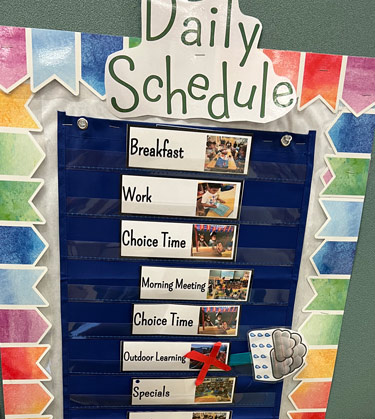Daily Schedules in the Early Childhood Classroom
Establishing an effective prekindergarten daily schedule requires planning intentional interactions and integration of a variety of play-based experiences to deepen and extend the learning process. Ensuring the implementation of developmentally appropriate practices ensures that children have sufficient opportunities to practice new skills in a variety of ways and within different settings throughout the classroom. High-quality instructional materials will integrate various concepts and activities across different parts of the day, providing an integrated approach to learning. With the principles of meeting the individual needs of the child, instruction within the prekindergarten program should include opportunities for both individual and group activities to allow for independent exploration and play as well as socialization.
Effective PK3 and PK4 daily classroom schedules should include:
- Integrated learning where concepts are taught in an interdependent way, rather than content-specific learning where concepts are taught in silos
- A balance between teacher-directed & child-driven (choice) learning experiences including a balance between rest and movement
- A variety of developmentally appropriate, hands-on, play-based activities
- Intentionally designed and interdisciplinary learning center opportunities
- Relevant and meaningful activities that present concrete experiences (e.g., use of all five senses)
- Opportunities for relationship-building and communicative experiences with peers
- Activity goals that are aligned with the Texas Prekindergarten Guidelines (TPG) domains and outcomes
- A variety of learning formats: whole group, small group, and independent work time
Note about “calendar time” in prekindergarten classrooms
The involvement of calendar time has continued to be a common practice in the prekindergarten classroom. However, it is important to take note of the activities that occur during calendar time. For a child to participate in calendar activities, they must have an understanding that time is sequential and be able to conceptualize past and future events (TPG PK4.VII.A.3). If we think about the development of our PK3 and PK4 students, they may not have the ability to judge the length of time across days, weeks, or months. What children are able to comprehend is the ability to understand time as it occurs within the immediate school day (as demonstrated through the review of the daily schedule- TPG PK3/PK4.V.D.4). In addition, calendar time can be used to support concrete mathematics skills such as numeral recognition, one-to-one correspondence, rote counting, and patterning.
Schedule Guidance for Prekindergarten Classrooms
A daily schedule should be displayed at the child’s eye level and contain words and pictures/icons for identification:
- The daily schedule should be referenced throughout the school day, and consistently followed, although adaptations should be made based on student/program needs.
- A daily schedule should include ample time for transitions and self-help procedures such as toileting, handwashing, and gathering personal belongings.
- Daily group activities should include cross-content learning experiences throughout the school day.
- Daily schedules may consider guidance from the use of adopted high-quality prekindergarten instructional materials (curriculum).
Activity Guidance for Early Childhood Classrooms
Suggestions of activities and settings in which they may take place include the following:
- Whole/large group: Teachers gather the entire class in a large open area to provide information and build community. Large-group sessions should last no more than 15‒20 minutes as the teacher may engage in the following activities:
- Read-aloud, music and movement, morning message, daily schedule review, attendance/helper chart, learning center/theme review, experiments, inquiry-based discussions, show and tell
- Partner activities can occur during a whole group activity when students are seated next to a partner and are able to interact given adult facilitation (e.g., “think-pair-share”)
- Small group: The teacher provides a balance of deeper understanding through intentional instruction of concepts, differentiated instruction, and child-led, hands-on experiences for a short period of time (10‒15 minutes). The activities should be engaging and include open-ended conversations, with children taking an active role using manipulatives, books, and pictures as opposed to worksheets or flashcards. Small group activities might include content review, collaborative learning (e.g., pair-share, partner activities), art and writing experiences, or hands-on projects.
Note that this is not an exhaustive list. Adopted instructional materials should be referenced for daily schedule/activity guidance.
Daily Schedule – Samples for Prekindergarten
Half-Day Schedule
Time and activities
- 15 min – child arrival and independent or whole group activity
- 15 min – whole group
- 15 min – small group
- 60 min – learning centers
- 15 min – whole group
- 30 min – outdoor time
- 15 min – snack time
- 15 min – closing/reflection
Total: 180 minutes
*Transitions/toileting not included in examples.
Full-Day Schedule
Time and activities
- 15 min – child arrival and independent or whole group activity
- 15 min – snack time
- 15 min – whole group
- 15 min – small group
- 60 min – learning centers
- 30 min – outdoor time
- 30 min – lunch time
- 90 min – rest time (refer to local program guidelines)
- 15 min – whole group
- 30 min – outdoor time
- 60 min – learning centers/independent activities
- 15 min – whole group
- 10 min – closing/reflection
Total: 400 minutes
*Transitions/toileting not included in examples.
References
Klibanoff, R., S. Levine, J. Huttenlocher, M. Vasilyeva, and L. Hedges. 2006. Preschool Children’s Mathematical Knowledge: The Effect of Teacher ‘Math Talk.’ Developmental Psychology 42 (1): 59–69.
Bustamante, A., A. Hindman, C. Champagne, and B. Wasik. 2018. Circle Time Revisited: How Do Preschool Classrooms Use This Part of the Day? The Elementary School Journal 118 (4): 610–31.
Stipek, D. n.d. Making Circle Time Count. Development and Research in Early Mathematics Education. Accessed May 3, 2023.


